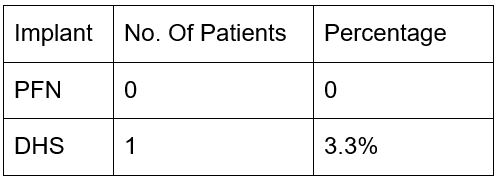A comparative study of intramedullary and extramedullary fixation devices in type two unstable trochanteric fractures
Abstract
Background: For many years, the sliding hip screw and plate had been the gold standard in treating pertrochanteric fractures. Nowadays, there is an increasing interest in intramedullary nailing. Intramedullary devices, although technically difficult seems to have a biomechanical advantage over laterally fixed side plates2.Literature is full of articles categorizing DHS in stable Trochanteric fractures, (31-A1.1, A1.2, A1.3 and 31-A2.1) and use of intramedullary devices PFN as implant of choice in unstable trochanteric, sub trochanteric fractures and particularly in reverse oblique (all A 31.3). But there is always a grey zone of decision of implant to be applied in unstable type A2.2 and A2.3 fractures. This study was designed to compare functional outcome and complications of the PFN device with those of a traditional extramedullary device, the Dynamic hip screw (DHS), inpatients with unstable type 2 trochanteric fracture. (AO/ASIF Classification 31-A2.2 & 31-A2.3)
Method: In this Randomised control prospectively, designed study 60 consecutive patients having Fracture according to AO/ASIF classification 31-A2.2 and 31-A2.3 are included and randomized to either PFN or DHS group. The functional outcome and clinical results of the patients was evaluated and graded using HARRIS HIP SCORE system.
Results: The average blood loss in PFN was 88.3ml while in DHS it was 318.33ml. Hospital stay after surgery in PFN was average days 4.13 DHS was average days 5.63. Harris hip score in PFN 22 (73.33%) were good, 06 (20%) were fair and 02 (6.66%) while with DHS 12 (40%)were good, 12(40%) were fair and 06 (20%).Average time of union in PFN was 13.4 weeks in DHS was 15.1 weeks.
Conclusion: In Type 2 unstable trochanteric fractures PFN gives advantage of lesser blood loss, shorter operating time, faster union, better functional outcome with low complication rate as compared to DHS.
Downloads
References
Curtis, M.J. & Jinnah, R.H. & Wilson, V & Cunningham, B.W.. (1994). Proximal femoral fractures: a biomechanical study to compare intramedullary and extramedullary fixation. Injury. 25. 99-104. 10.1016/0020-1383(94)90111-2.
Orthopaedic Trauma Association Classification, Database and Outcomes Committee. Fracture and dislocation classification compendium - 2007. J Orthop Trauma 2007; 10 Suppl.)
Harris WH. Traumatic arthritis of the hip after dislocation and acetabular fractures: treatment by mold arthroplasty. An end-result study using a new method of result evaluation. J Bone Joint Surg Am 1969; 51:737–55
Ujjal Bhakat, Ranadeb Bandyopadhayay, Comparitive Study between Proximal Femoral Nailing and Dynamic Hip Screwin Intertrochanteric Fracture of Femur, Open Journal of Orthopedics, 22013, 3, 291-295
Neritan Myderrizi, Proximal femoral nailing is better choice in treatment of intertrochanteric fracture in elderly people.International Surgery Journal Myderrizi N. Int Surg J. 2016 May;3(2):781-785
Richard Armelin Borger, “prospective assessment of the clinical, radiographic and functional evolution of treatment for unstable. Trochanteric fractures of the femur using a cephalomedullary nail”, Revista Brasileira de Ortopedia Rev. bras. ortop. vol.46 no.4 São Paulo 2011 Print version ISSN 0102-3616
S.K. Venkatesh Gupta, Veera Shekar Valisetti,Comparative study between dynamic hip screw vs proximal femoral nailing in inter-trochanteric fractures of the femur in adults, International Journal of Orthopaedics Sciences 2015; 1(1): 07-11.ISSN: 2395-1958IJOS 2015;
Umesh M. Shivanna, Girish H. Rudrappa. “A Comparative Study of Functional Outcome between Dynamic Hip Screw and Proximal Femoral Nail in Surgical Management of Per-Trochanteric Fractures”. Journal of Evolution of Medical and Dental Sciences 2015; Vol. 4, Issue 43, May 28; Page: 7489-7498,
Hemant Sharma, Deepinder Singh Loomba,Comparison of outcome of management of unstable pertrochanteric femoral fractures with dynamic hip screw and proximal femoral nail,African Journal of Trauma |Jan-Jun-2015|Vol.4| Issue 1,DOI:10.4103/1597-1112.162236.

The entire contents of the Orthopaedic Journal of Madhya Pradesh Chapter are protected under Indian and International copyrights. Orthopaedic Journal of Madhya Pradesh Chapter allow authors to retain the copyrights of their papers without restrictions, Authors grant the publisher the right of exclusive publication. The Journal then grants to all users a free, irrevocable, worldwide, perpetual right of access to, and a license to copy, use, distribute, perform and display the work publicly and to make and distribute derivative works in any digital medium for any reasonable non-commercial purpose, subject to proper attribution of authorship. The journal also grants the right to make numbers of printed copies for their personal non-commercial use under Creative Commons Attribution-Non-commercial share alike 4.0 International Public License.

 OAI - Open Archives Initiative
OAI - Open Archives Initiative












